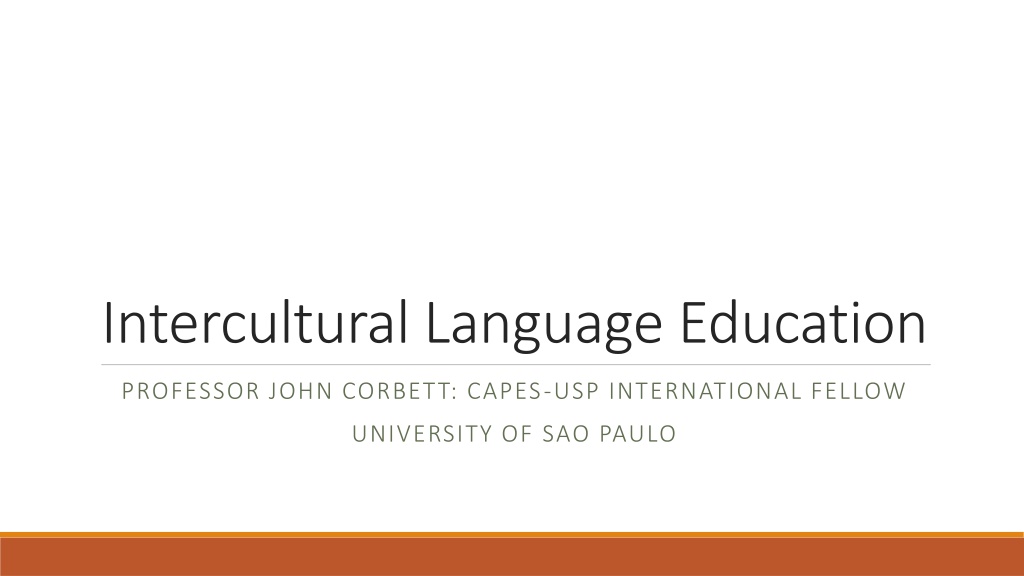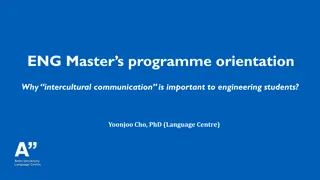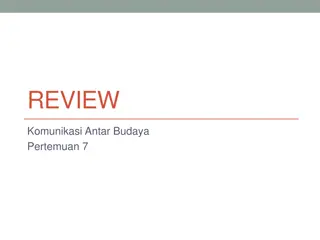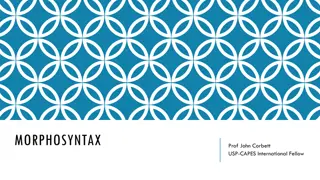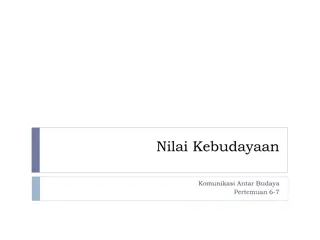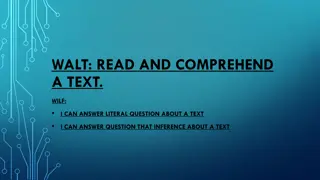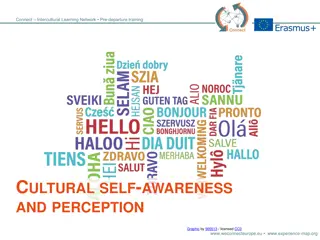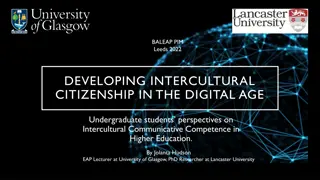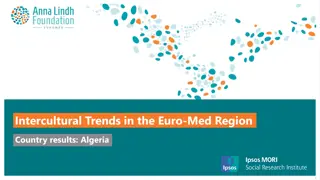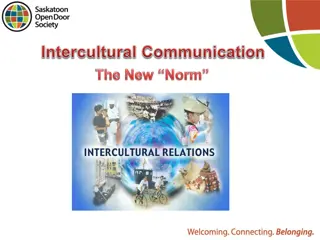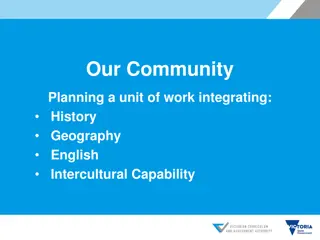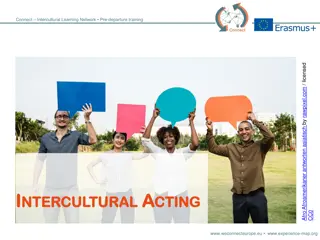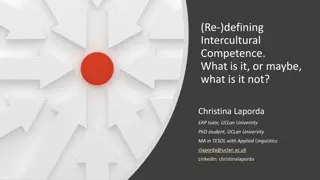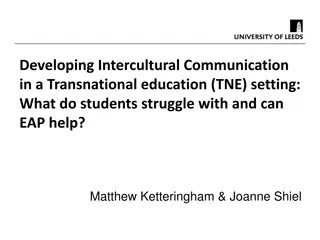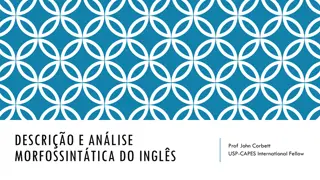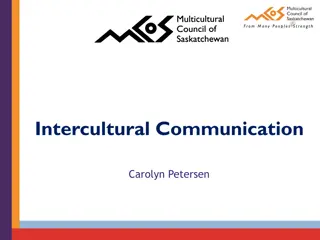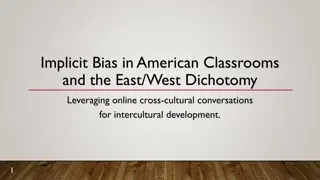Exploring Intercultural Language Education with Professor John Corbett
Dive into the world of intercultural language education with Professor John Corbett's comprehensive course at the University of Sao Paulo. The program covers essential topics such as ethnographic approaches, curriculum design, and feedback in a blended learning format. Explore competing notions of language and culture education, the influence of documents like the CEFR, and strategies for understanding individual identity while avoiding preconceptions.
Uploaded on Oct 06, 2024 | 0 Views
Download Presentation

Please find below an Image/Link to download the presentation.
The content on the website is provided AS IS for your information and personal use only. It may not be sold, licensed, or shared on other websites without obtaining consent from the author. Download presentation by click this link. If you encounter any issues during the download, it is possible that the publisher has removed the file from their server.
E N D
Presentation Transcript
Intercultural Language Education PROFESSOR JOHN CORBETT: CAPES-USP INTERNATIONAL FELLOW UNIVERSITY OF SAO PAULO
Review of content The course has been designed as a 6-week blended learning programme, consisting of the equivalent of 24 contact hours: 1. Introduction to intercultural language education (f2f lecture and discussion) 2. Ethnographic approaches 1: fieldwork (online reading and activities) 3. Ethnographic approaches 2: telecollaboration (online reading and activities) 4. CEFR and ILE 1: institutionalising ILE (online reading and activities) 5. CEFR and ILE 2: exporting a curricular framework (online reading and activities) 6. Feedback and critical approaches to ILE (f2f lecture and discussion) The follow-up course looks at more practical classroom approaches to ILE, eg class projects & materials design.
Topics for further discussion Competing notions of language and culture education - have the concepts language and culture 'served their time', as Marina suggests, and, if so, do we need to replace them? Or are they still useful if we define them clearly - and if so, how? Where should a contemporary language teacher start, in his or her exploration of theory? How would you design a curriculum to introduce novice language teachers to the ideas in this course?
Topics for further discussion or disempowering document? Can it be saved? Does it have a positive or negative (or negliglible) influence on the teaching of English (or German, or Spanish) in Brazil? Where do you stand on the CEFR - is it an empowering as you start talking to the students on the Hemispheres Connection project? Is it stimulating, or do you feel the frustrations voiced by Robert O'Dowd? Or both? How are you finding the 'virtual ethnography' online,
Dirven on ICC: Identity Seek a deeper understanding of individual people s identity by a) avoiding preconceptions b) appreciating complexity c) not overgeneralising from individual instances. Achieve this by employing bracketing to put aside your preconceptions, thick description to enable you to see complexity, and an appreciation of emergent data to signal the unexpected.
Identity: towards a thick description 1. respond to people according to how you find them rather than according to what you have heard about them 2. avoid easy answers about how people are. Bracket put aside simplistic notions about what is real or unreal in your perception of another culture 3. appreciate that every society is as complex and culturally varied as your own. 4. learn to build up thick descriptions of what happens between you and the others to work out to communicate as you go along. 5. while respecting whatever people say about their own culture, take what they sat as evidence of what they wish to project rather than as information about where they come from.
Identity: towards a thick description 6. take what people say about their culture as a personal observation which should not be generalized to other people who come from the same background. 7. understand how people are creating and indeed negotiating their cultural identity in the very process of communicating with us. 8. appreciate that you are creating and negotiating your own cultural identity in the process of communicating with us. 9. appreciate that the creation and negotiation of cultural and personal identity are the same thing.
Dirven on ICC: Otherization Seek a deeper understanding of the prejudices, preoccupations and discourses which lead you to otherize. Use this to enable bracketing and to manage your own role in communication. 10. avoid falling into the culturalist trap of reducing people to less than they are in the same way as we must avoid racial and sexist traps. 11. be aware that what happens between yourself and others is influenced very much by the environment within which you are communicating and your own preoccupations. 12. become aware of your own preoccupations in order to understand what it is that people from other backgrounds are responding to. 13. avoid being seduced by previous experience and the exotic 14. monitor your own language and be aware of the destructive, culturalist discourses we might be conforming to or perpetuating.
Dirven on ICC: Representation Seek a deeper understanding of the representations of the foreign Other which are perpetuated by society. 15. be aware of the media, political and institutional influences in our own society which lead us to see people from other cultural backgrounds in a certain way. 16. see through these images and fictions when we encounter people from other cultural background, and always try to consider alternative representations
Dirven on ICC: Representation 17. be aware of dominant discourses which are easily perpetuated by the media, and which lead us to think-as-usual that familiar images of the foreign Other are normal 18. be aware that even images projected by sensitive, intellectual sources can seduce our own sensitivities and intellects into thinking that they are true 19. although sensationalism in the media is something we know about and guard against, we need to appreciate how deeply it exists in our traditional views of the foreign other.
Key elements of proteophilic competences 1 - The importance of relationships in interaction is taken into account in the co-construction of identities and images of who one wants to be, how one presents oneself and the other in interaction
Key elements of proteophilic competences 2 - Emphasis is also laid on the fact that each individual constructs themselves and that in any act of interaction, it is well known that one never communicates with the person as s/he really is, but with a representation which we have of him/her and his/her groups of belonging, just as this person brings in the interaction act her own representations (Ogay, 2000: 166). The notions of representations and stereotypes are also at the heart of the various analyses that are proposed to students so that they learn to recognize these mechanisms of construction in their own discourse and in that of the other
Key elements of proteophilic competences 3 - The concept of the fantasy of Unicity (Maffesoli, 1995, i.e. the doxic idea that each of us has a unique self inside of them and that belonging to one s group makes us the same ) as well as the concept of dissociative acts /diversity of the self borrowed from psychology ( situations in which I am somebody and somebody else at the same time Boumard, 2006: 306) are central. Through these concepts, the approach requires that the students decentre and look at themselves.
Dervins model of ICC: 1. Savoir-faire (i) Detect identification I am fully aware that every individual (myself included) is multiple and complex but that every (inter-)locutor can adapt their discourse to contexts and/or interlocutors by presenting a group or a national identity in order to please, confirm a representation or defend themselves. I know how to note and analyse pieces of evidence of identification in my own discourse as well as in the other s discourse. As a consequence, whenever possible, I try not to present myself or my interlocutor through national images, stereotypes, generalisations and exaggerations
Dervins model of ICC: 1. Savoir-faire (i) a. Individual plurality is not always visible because, in any context of interaction, one needs to select an image of the self (and of the other) and use it. Moreover, classifying by means of nationality is very common in intercultural encounters (it is often a starting point, an overture). Also, I need to remember that telling somebody that they are using auto-/hetero-stereotypes ( We Finns are like this ) can be problematic because I can come across as moralizing and/or unpleasant. Who is entitled to forbid somebody from using a national auto-stereotype? What can thus be done in such a situation? I can play the stereotype-game, cut the conversation short, change topics, or discuss the stereotypes with my interlocutor. With hindsight, I can reflect on why I, or somebody else, used stereotypes in interaction and how they were formulated
Dervins model of ICC: 2. Savoir-faire (ii) Paying attention to discourses I am able to listen to discourses that I come across (mine as well as others ) especially when they are potentially ethnocentric, xenophobic, racist but also exotic and xenophilic. I know how to ease such discourses by means of linguistic markers such as modalities and be as explicit as possible by reformulating. I also try to avoid interculturally correct , naive or contradictory discourse on the self and the other such as I have no stereotypes , I don t believe in stereotypes but Finns are etc.
Dervins model of ICC: 2. Savoir-faire (ii) b. This is where language skills can have a big impact on intercultural competences (mine and that of my interlocutor) because one cannot always control all the meanings and nuances in a foreign language and one can also shock one s interlocutor without even knowing (s/he may not even be showing their real feelings in relation to this situation/context). What strategies could I use in such instances without putting myself at risk?
Dervins model of ICC: 2. Savoir-faire (ii) b. Secondly, the other can have a role to play in my use of language, with stereotypes being a case in point. For instance, there might be times when my avoidance of stereotypes is limited by an interlocutor whose position is hierarchically higher. How might I behave in an ethical manner in such a situation and try not to resort to stereotypes? Finally, I should bear in mind that there is a potential gap between discourses and acts - in other words, I am aware that discourse can be contradicted by actions and vice-versa.
Dervinsmodel of ICC: 3. Savoir-ragir/agir Controlling one s emotions/behaviours In delicate and difficult situations, situations of misunderstanding and disagreement, I make an effort to remind myself that individuals are human beings and that they have emotions, feelings, experience bad/good moods, personal problems which influence their reactions. As such, I try not to draw quick and culturalist conclusions which may harm my relationships with others.
Dervinsmodel of ICC: 3. Savoir-ragir/agir c. How might I therefore control my emotions in difficult situations? What strategies could be used to avoid conflicts or worsening situations? How might I go beyond feelings of d j -vu, d j -v cu, d j -dit and phenomena of polyphony which may affect my relationships with others (e.g. a person reminds me of someone that I do not like either because of her/his physical appearance or his/her accent in a foreign language)?
Take home aphorism Intercultural competence is not permanent, for life , and its practice and learning never end.
